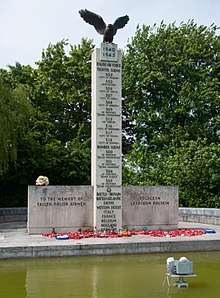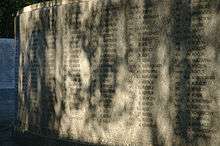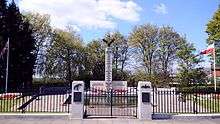Polish War Memorial
The Polish War Memorial is a war memorial in West London, England in memory of airmen from Poland who served in the Royal Air Force as part of the Polish contribution to World War II. It is in South Ruislip in the London Borough of Hillingdon beside the A40 road at the roundabout junction with the A4180 road.[1] It is located near RAF Northolt, where seven Polish-manned fighter squadrons were based at different times in the war.

The monument is a prominent local landmark. The term "Polish War Memorial" is commonly used as the name of the junction between A40 and A4180 roads, as well as for the monument itself.
The monument is a Grade II listed building.[2]
History
Officers from the Polish Air Forces in France and Great Britain who settled in Britain after the war formed the Polish Air Force Association. They decided to erect a monument and a committee, led by Air Vice Marshal M Izycki, raised the necessary funds mostly from the British public. It was unveiled on 2 November 1948 by Lord Tedder, Chief of the Air Staff, after a speech by Viscount Portal of Hungerford in which he said that it was a sad blow that many Polish veterans were unable to return home, as their country had been occupied by the Soviet Union. He added that it would be to the mutual advantage of Britons and Poles that the latter were to make their home in Britain.[1]
The Polish sculptor Mieczysław Lubelski, who had served in the 1944 Warsaw Uprising and been interned in a German concentration camp, designed the monument. It is made from Portland stone and polished granite with bronze lettering. It is surmounted by a bronze Polish eagle, which is the symbol of the Polish Air Force.[3]
Refurbishment and extension

Originally the names of 1,243 Polish airmen who died during the war were inscribed on the monument. Subsequently, another 659 Poles were identified whose names should be on the monument. By the 1990s the monument needed refurbishment, so in 1994 an appeal was launched to fund the work. At the same time the opportunity was taken to extend the monument to add the 659 missing names. In 1996 the work was completed and the Duke of Gloucester rededicated the enlarged, refurbished monument.[1]
Presidential visits
Two Presidents of Poland have laid a wreath the monument: Lech Wałęsa in 1991 and Aleksander Kwaśniewski in 2004.[4] The monument was refurbished in 2010 in time for the 70th anniversary of the Battle of Britain. In September 2012 a replica of the Polish wartime standard, the Wilno Standard, was paraded at the monument as part of a memorial ceremony.[5]
Garden

On 5 September 2015, to commemorate the 75th anniversary of the Battle of Britain, a Polish War Memorial Garden was opened behind the monument by the leader of Hillingdon Borough Council, Ray Puddifoot, and the Polish Ambassador to the United Kingdom, Witold Sobków. It includes a separate monument in both English and Polish.[6]
Other Polish war memorials
There are numerous other Polish war memorials in the United Kingdom. In England they are in St Clement Danes Church in London and at Audley End, Bradley, North Yorkshire, Brookwood Military Cemetery, Buckden Pike, the former RAF Chailey, between Terminals 2 and 3 at Manchester International Airport (which had been RAF Ringway), the National Memorial Arboretum, Newark-on-Trent and Plymouth. Wales has Polish monuments in Cardiff and Wrexham. Scotland has Polish monuments at Douglas, South Lanarkshire, Duns, Invergordon, Perth and Prestwick.
See also
- List of public art in Hillingdon
- Polish Air Forces in France and Great Britain
References
- "Polish War Memorial". War memorials. London Borough of Ealing. Retrieved 20 October 2013.
- Historic England, "The Polish War Memorial, at the Junction with Western Avenue (1088113)", National Heritage List for England, retrieved 14 July 2016
- "Polish War Memorial". Parks and open spaces. London Borough of Hillingdon. Retrieved 7 November 2017.
- "Polish president welcomed to UK". BBC News. 5 May 2004. Retrieved 8 March 2011.
- Drewett, Zoe (12 September 2012). "Replica wartime flag unveiled at Polish memorial ceremony". Uxbridge Gazette. Trinity Mirror. Retrieved 10 November 2012.
- Clementine, Katherine (11 September 2015). "Polish war memorial remembrance garden opened to mark 75 years since Battle of Britain". Uxbridge Gazette. Trinity Mirror. Retrieved 31 August 2017.
External links
| Wikimedia Commons has media related to Polish War Memorial. |
- "The Polish War Memorial, Northolt". Places of Interest. Battle of Britain London Monument.
- "The Polish War Memorial". Ruislip Online. Archived from the original on 16 September 2008. Retrieved 12 July 2008. – photographs of the monument
